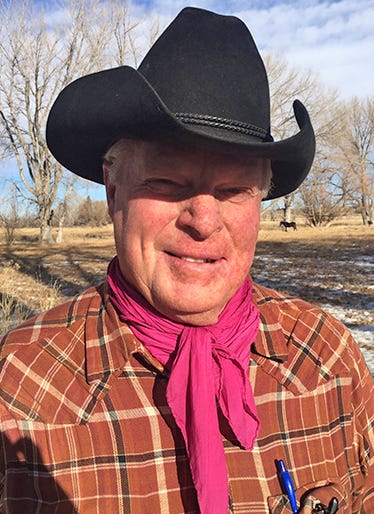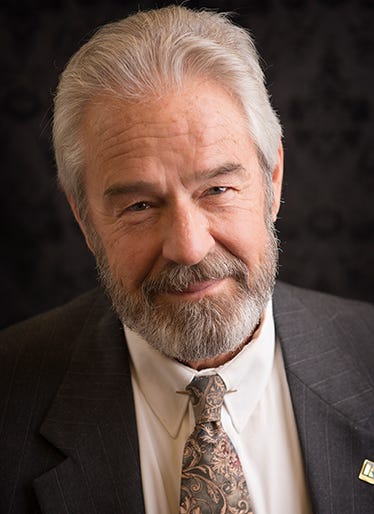April 30, 2019

“What we do is a bit complicated. Initially, a little confusion would be perfectly normal,” explains Wyoming real estate broker Frank Deede, who developed the enhanced collateral program with three business partners.

WORKING WITH COLLATERAL: Frank Deede developed the enhanced collateral program and has put it to work from his Wyoming business.

Their model is designed to help ranchers, farmers and agribusinesses with solid equity expand operations without taking on long-term debt or incurring high out-of-pocket cash outlays.
Deede says those qualifying for the program use a two-asset mix to cover debt repayments: enhanced collateral and real estate.
“This is a very sophisticated financial model that uses enhanced collateral — such as high-quality, government-backed securities — blended with real estate equity,” he explains. “The debt repayment comes primarily from the enhanced collateral asset, which reduces the typical out-of-pocket cash costs of servicing the debt from normal agricultural production income.”
One of Deede’s business partners, Bob Dobson, says that an important goal of this financing model is to achieve cash flow insulated from annual crop yields, cattle prices and other variables.

PARTNER IN REAL ESTATE: Bob Dobson, Frank Deede’s business partner, says that insulating cash flow from annual crop yields, cattle prices and other variables is key

“When trying to purchase agricultural land, it’s very difficult to pay for a traditional 30-year loan with normal crop and cattle income, combined with the high cost of real estate,” says Dobson, a real estate broker and large animal nutrition consultant based in Fort Collins, Colo. “But a program like this helps producers pay off debt independently of the underlying real estate and other market factors, and they can do this generally over a seven- to 10-year period.”
Solid equity needed
Dobson and Deede emphasize that their model will only work for operations with rock-solid equity.
“Let’s say your farm or ranch is worth $5 million; this kind of funding model for expansion can be achieved if you currently can create a 50% to 70% loan-to-value rate,” Deede notes. “At this time, it’s not a plan for the beginning farmer or rancher without large equity positions, due to the lack of flexible financing options.”
He adds that producers or agribusiness owners using the program must manage it carefully to avoid problems.
“It’s not a 100% autopilot arrangement. You just can’t sit back on your hands,” Deede stresses. “With this model, you’re putting together a loan not only on your agricultural income, but also the enhanced collateral income. You need to pay close attention to both income streams.”
The Idaho farmer whose family is using the program to expand its business encourages producers interested in using such a model to do serious homework before committing.
“The most critical thing in my mind is that you need to understand your financial position inside and out before you attempt to do something like this. You don’t want to take on more risk than you can handle,” the farmer emphasizes. “This is definitely a tool that can help farms and ranches with good equity acquire land for present and future generations. But if you’re trying to fix a bad financial problem, this program isn’t for you.”
Funding model and succession planning
Deede says the enhanced collateral model that he and associates developed could help ranchers and farmers use their property’s equity to help with expansion, estate and succession planning, or to generate a greater cash flow.
“The program can work especially well for refinancing, estate settlements or expansion of real estate with underlying high equity,” Deede says.
“If this model is to be applied to succession planning, for example, you would be using debt for the purposes of a family buyout or to provide an income stream for a retiring family member,” he says. “The debt would be designed in such a manner to self-liquidate in approximately seven years or so, therefore not requiring a traditional 30-year debt.”
Deede shared a number of examples, including the following: Let’s say Mom and Dad want to retire and sell their farm at market rate to a son who works on the farm, while providing equal inheritances to not only that child but to two other children who pursued careers elsewhere.
“Under normal circumstances, how in the world could a couple do that if their son purchased the farm with a traditional 30-year loan?” Deede asks. “But, when you start blending an enhanced collateral situation into the mix, you can allow for succession at market rates and still create an arrangement to buy out the other family members.”
Secure future for parents, children
An Idaho farmer says his family is using the program, in part, to help provide a secure retirement for his parents while also paving the way for the next generation.
“A sibling and I represent the fifth generation of agriculture in our family, and every year I’m amazed by the miracle of plant growth, seeing how 2 bushels can become 130 bushels,” he says.
The farmer adds that he is confident the unusual funding model that his family is using will help the sixth generation see through those same passionate eyes. “So far, the plan is working exactly as it was intended to work.”
To learn more about the enhanced collateral model, contact Frank Deede at 307-851-2426 or [email protected], or the program’s manager, Bob Dobson, at 970-215-7173 or [email protected].
Deede owns RuraLands, a Pavillion, Wyo.-based real estate company specializing in agricultural and rural lands. The 68-year-old is also a registered Hereford breeder.
Dobson was the Western Feed Division nutrition director for Land O’Lakes from 1984 to 2000, when he launched a career in real estate and beef and dairy cattle nutrition consulting in Colorado.
Waggener writes from Laramie, Wyo.
About the Author(s)
You May Also Like




